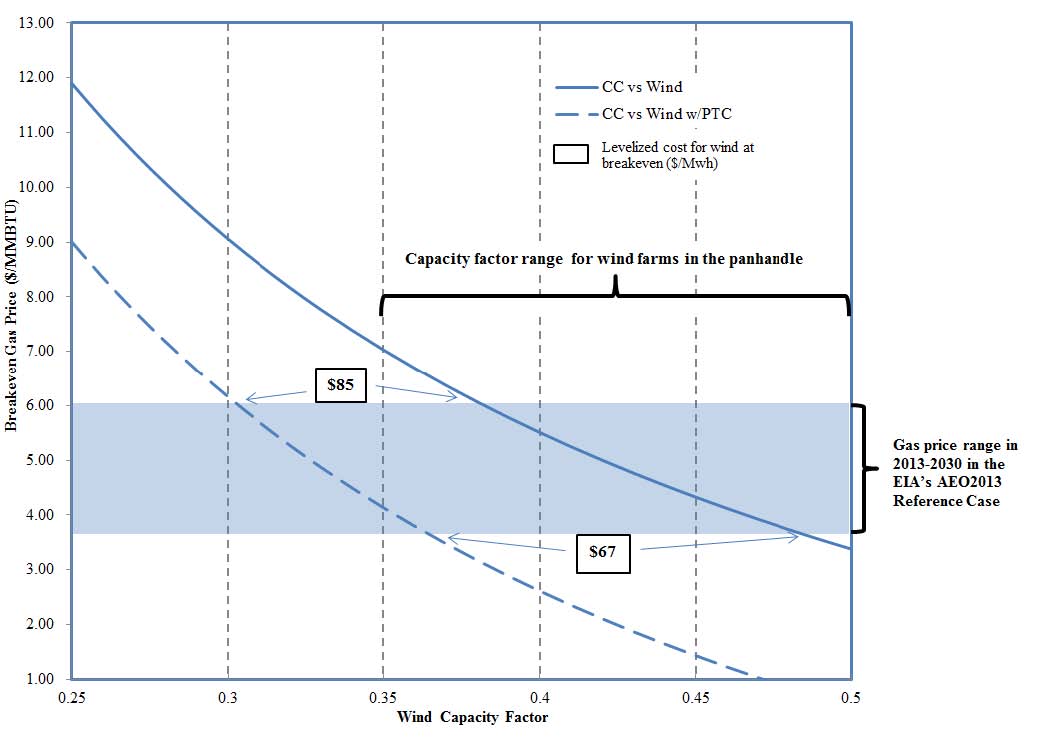I found a fascinating document the other day. Now, having read and digested it, I am prepared to share some things.
One of the bigger complaints I hear about wind power is that it’s just not competitive. The capacity factor is too low[1], it’s too expensive, and it’s in the wrong place.
Capacity Factor is the percentage of electricity actually produced compared to how much the unit can produce under ideal circumstances. It’s usually based on a yearly cycle. Even nuclear power plants have to be ‘down’ for maintenance sometimes. If you hear that an 800MW power plant is being built, then it will probably have a capacity factor of between 85% and 95%.
Wind and solar are a little different because they are more intermittent. The wind doesn’t blow all the time and the sun doesn’t shine all the time. So these generation facilities have much lower capacity factors than fossil fuels or nuclear plants. A lot of the anti-renewable groups say that wind is lucky to get a capacity factor of 15%. Meaning that a 1 Megawatt turbine will only generate about 150kW.
Now, after two years of hard data, we can say that the wind generation in the Texas averages 30.4%. Units in the panhandle are much higher and range from 35% to nearly 50%. That’s really, really good. It pales to the 98% that nuclear plants achieve, but it’s generally double to triple what is expected. The higher the capacity factor, the more electricity is produced and the more competitive wind turbines become.
This graph from the report shows this.
The Y-axis is the cost of natural gas (which is really cheap in Texas) and the X-axis is the capacity factor of the turbines. Gas prices as of today are about $4.00 on that y-axis (check current prices here). The dark blue line is the line of same cost for wind power and gas-fired power.
At a wind capacity factor of about 48% and a gas price of about $3.75 per MMBTU, wind and gas-fired produce electricity at the same price ($67 per Megawatt or $0.067 cents per kilowatt). Anything to the right of this line means that wind is actually cheaper than gas-fired power.
The dashed line shows what happens when you add in the $0.022 Production Tax Credit. If gas prices go up to $6 per MMBTU, then wind throughout Texas is competitive.
Yes, coal is cheaper. But not by as much as you think. Plus it has all those nasty side effects.
There are a couple of reasons that Texas is using gas-fired power and it’s working very well with the renewables, especially wind. Gas-fired power is much quicker to ramp-up and ramp-down. Say there’s a sudden surge in demand (like half-time at the super-bowl and everyone hits their microwave to warm up some queso). A coal plant must start burning coal and bring a large mass of water to a hard boil (and beyond), then the pressurized steam can be released and start turning a turbine to produce electricity. The superbowl itself will be over before a coal plant starts producing. The modern gas plants are more like cars (well, jet engines really). The burning gas turns a turbine directly and that spins a generator.
Modern gas plants have combined cycle systems. So the gas-turbine spins a generator, then it is cooled by water (or pipes are placed in the exhaust stream). This water turns to steam and drives another turbine (or adds more speed to the directly connected turbine). In simple terms, using waste heat to generate additional electricity. This improves the efficiency of a gas-fired plant from 35% or so, to 60% or so.
Natural gas is much cleaner burning. It’s not a zero emissions product by any means, but it’s a lot better than coal. For example, coal produced about 2300 lbs of carbon dioxide per megawatt hour of electricity while natural gas-fired plants produce half that, about 1135 pounds per megawatt hour. Natural gas produces less than one third the amount of nitrogen oxides and only 1% the amount of sulfur oxides.
Given a choice between coal and gas, I have to pick gas. Given a choice between anything and wind, I have to pick wind.
Now, here’s where it gets interesting. Texas has the most installed wind power of any state in the US. Wind provided 31 gigawatts of power in 2012 and, so far, appears to be headed for a much higher number in 2013. Texas also produces the most natural gas of any state.
Texas also has a law on the books, that renewable power must be built (Texas has already exceeded the original 2020 goal for renewable production) and that it must not be all wind power. Solar PV is expensive, but it’s really useful in Texas.
The reason that solar is so important in Texas is that it produces the most power when Texans need it the most… summer daytime. With record breaking heat waves over the last few years (2011 saw more than 45 days in a row with temps over 110°F) and a severe drought, cooling is expensive. As lake water levels fall, some power stations have literally not been able to produce power. This results in rolling blackouts and voluntary shutdowns for power customers.
Texas is also investing transmission lines from the wind farms to the main grid. Texas is fairly unique in being almost completely isolated (electrically) from the rest of the US. It is very difficult to get excess power to the rest of the country and get power when needed.
So Texas, is an ideal testbed to look at policies and practices that integrate renewable power in a production environment.

